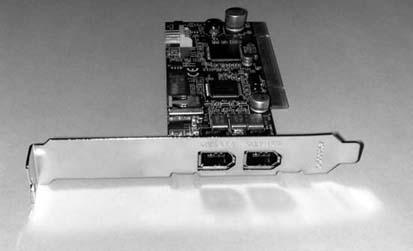Installing a FireWire Card
Most computer stores, both retail and online, sell FireWire/1394 expansion cards (Figure 2-3); they’re available for both desktop and laptop computers. FireWire cards designed for desktop machines fit into one of the computer’s spare PCI slots on the motherboard, making the new FireWire ports available on the back of the case along with all the other port connectors.

Figure 2-3. FireWire cards come in all shapes and sizes and can add two, three, or four FireWire ports to a computer. The cards snap into an empty PCI slot on the computer’s motherboard. Adding a FireWire card will allow you to use FireWire-enabled devices like digital camcorders, CD burners, and iPods.
There are expansion cards for FireWire, USB 2.0, and even combo cards that let you add ports for FireWire and USB 2.0 if you really want to go whole-hog toward faster data-transfer speeds. A basic FireWire card generally sells for less than $60, a relatively small price to pay to give your computer the gift of FireWire.
FireWire cards for laptops, which are generally more expensive than the PCI cards, snap into the CardBus slot on the laptop. (CardBus is a ramped-up version of the PC cards used with laptops.) Most laptops manufactured after 1999 can handle CardBus cards, in either FireWire or USB 2.0 flavors.
Before you buy a FireWire card, make sure it’s compatible with your operating system ...
Get iPod and iTunes: The Missing Manual, Third Edition now with the O’Reilly learning platform.
O’Reilly members experience books, live events, courses curated by job role, and more from O’Reilly and nearly 200 top publishers.

